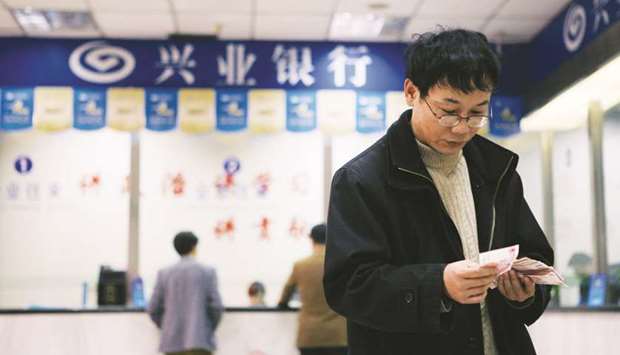For a managed currency, the direction of China’s yuan is proving hard to predict.
Despite a constant drumbeat from policymakers that it would be kept “stable” in 2017, the year of the all-important Communist Party Congress, the currency has made a stunning about turn.
After two years of beating back the bears, Beijing is now being confronted with the opposite problem as the dollar’s slide fuels appreciation pressure.
While they initially embraced the yuan’s reversal of fortunes, officials gave the first clear signal the surge had gone far enough on Monday, when they eased curbs on shorting the currency imposed shortly after the 2015 devaluation.
Now, amid a newfound thirst for yuan at home and an uncertain outlook for the greenback, the People’s Bank of China may have to pull out the big guns - direct intervention and a loosening of capital controls – as it deconstructs the rampart it has built over the past two years to protect against yuan losses.
“My hunch is that the PBoC has been taken slightly off guard by the dollar’s about turn,” said George Magnus, an associate at Oxford University’s China Centre and former adviser at UBS Group AG. “The error that the PBoC may have made was to let the yuan rise by 7% against the dollar in the first place – perhaps they could have curtailed it, or even used it as an opportunity to take a major step toward floating the currency.”
Whether it was a mistake or not is debatable, but it wouldn’t be the first time that China - a country used to wielding control – has struggled bending the market to its will.
The August 2015 devaluation triggered a sustained selloff in the yuan that prompted the central bank to drain foreign-currency reserves and ramp up controls on outbound capital.
While the curbs helped stabilise the currency, the dollar’s slump this year has done some of the heavy lifting – perhaps too much. Buying momentum in the yuan, Asia’s best performer over the past three months, rose to the highest in 12 years last week.
Monday’s policy move has punctured the yuan’s exuberance, and there are other signs the PBoC is wanting to arrest the yuan’s advance.
At least three of its daily fixings – a rate used to restrict and guide the currency’s onshore moves – came in weaker than the market expected over the past two weeks.
Lu Lei, deputy administrator of China’s currency regulator, said the yuan’s flexibility will continue to be increased, the state-run Securities Times reported yesterday. The central bank, which typically doesn’t comment on its activities in the currency market, didn’t respond to faxed questions.
Meanwhile, the yuan has resumed gains, rising 0.07% to 6.5315 per dollar yesterday in Shanghai, after retreating 0.8% over the previous three days.
The potential impact on exports will make the authorities less tolerant of strength, says MK Tang, senior China economist at Goldman Sachs Group.
This week, the yuan touched a 2017 high against the currencies of China’s major trading partners, and if appreciation pressures continue to build the PBoC may directly intervene, Tang said.
But Beijing may face pushback from the exporters themselves, with companies that built up dollar stockpiles during the yuan’s weakening period now looking to convert, according to United Overseas Bank.
The newfound buoyancy in the mainland stock market is also being partly attributed to the revived appeal of the yuan.
There’s also the dollar factor. Down almost 10% versus major currencies this year, the greenback’s outlook is a black box, with any revival dependent on the tone set by the Federal Reserve – which meets next week – and President Donald Trump’s ability to make good on promises of tax reform and infrastructure spending.
Chi Lo, Greater China senior economist at BNP Paribas Asset Management, is also in the intervention camp.
The PBoC may buy dollars “to keep the currency from overshooting” and to preserve economic stability, he said.
While strategists expect the yuan to shed about 2.6% to 6.7 by year-end, the forwards market is less bearish, putting the currency at 6.58, according to data compiled by Bloomberg. Persistent rising pressure could also see the PBoC relax capital controls “gradually throughout the rest of this year,” says Shen Jianguang, chief Asia economist at Mizuho Securities Asia in Hong Kong.
Policy makers may ease curbs around individual and company foreign-exchange purchases, potentially scrapping the complicated application form that mainland residents need to complete when they buy dollars, Shen said. The government may also encourage more Chinese firms to invest in the manufacturing industry overseas.
Sue Trinh, head of Asia foreign-exchange strategy at RBC Capital Markets, sees the PBoC potentially taking a less visible route, intervening via the forwards market to make their activities less obvious during a high-stakes period politically.
The congress, due to start October 18, will see a once-in-five-years reshuffle in China’s leadership, and Trump may make his first visit to the world’s second-largest economy in November.
Whatever route it takes, the central bank probably won’t telegraph its intentions, says Hao Hong, chief strategist at Bocom International Holdings Co in Hong Kong.
Speculators tend to pile into trades seen as being endorsed by the PBoC given its grip over yuan trading. The perception that the currency had become a risk-free, one-way bet may have contributed to its strong run-up over the past few months.
“By keeping its general policies mysterious and only sending signals when necessary, the PBoC has made their measures to affect or jawbone the exchange rate more effective,” Hong said. “China will continue to remain mysterious, and this is probably desired.”

A customer counts his yuan notes at a branch of Industrial Bank Co in Shanghai. The yuan has resumed gains, rising 0.07% to 6.5315 per dollar yesterday in Shanghai, after retreating 0.8% over the previous three days.
